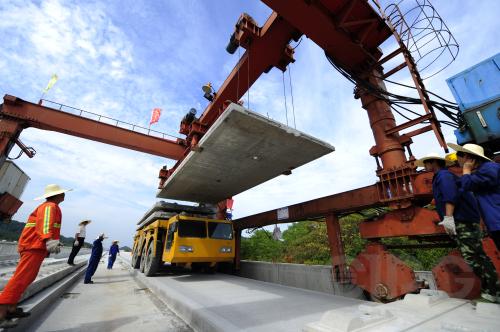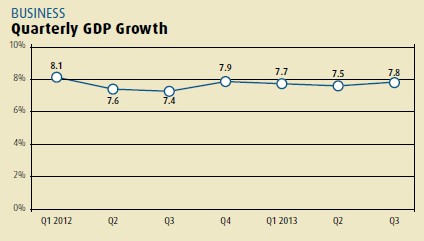| 
Pollution control facilities at Huanghua Port in Hebei Province
China's economic growth is picking up in astable way, with GDP increasing 7.8 percent in the third quarter, higher than the 7.5 percent in the second, according to data from the National Bureau of Statistics (NBS) on October 18. However, compared with a strong rebound in July and August, the economic upswing in September is not sustainable. Therefore, emphasis should be laid on stimulating and stabilizing economic growth while carrying out restructuring.
The rebound
In the first half year,China's economy witnessed a slight slowdown, with GDP growth dropping from 7.7 percent in the first quarter to 7.5 percent in the second. The Central Government's minimum target for growth is 7.5 percent, and panic was rife at home whenChina's growth met the lower limit. Many international economic think tanks and institutions believedChinawould suffer a hard landing.
The Chinese Government says it would do all it can to keep at or above 7.5 percent by reducing bureaucracy, expanding more pilot programs to replace business with a value-added tax, promoting interest rate liberalization and carrying out reforms on infrastructure investment and the price of resources.
These policies have quickly shown results. Since July, the prices of raw materials like petroleum, steel and non-ferrous metals saw an upward trend. In September, the purchase management index (PMI) was 51.1 percent, rising for three consecutive months, while electricity generation and transportation have also rallied.
According to statistics from the NBS, fixed-asset investment shot up by 20.4 percent in the third quarter, following the State Council's unveiling of favorable measures regarding the expansion of high-speed railways and subways, energy conservation, emission reduction and a Broadband-China strategy.
From January to September, the total retail sales of consumer goods increased by 12.9 percent, edging up slightly from the same period last year. Due to the Central Government's ban on extravagant and costly banquets on the public dime, revenue in China's catering sector rose a mere 8.9 percent from January to September, down by 4.3 percentage points year on year.However, furniture, building and home decorative materials sales kept expanding rapidly and show signs of a rebound.
Growth in the service industry remained flat due to the Central Government's efforts to reign in three major public expenses: vehicles, receptions and overseas trips.

Fluctuations
Despite a stable recovery ofChina's macro-economy beginning in July, there has been a lack of growth momentum overall. Though the PMI hit a record high in September, it only rose slightly month to month and failed to meet expectations.
The State Information Center, a government think tank, has given three explanations. First, the slow growth of incomes. Incomes for urban and rural residents grew at a pace slower than that of the GDP. In addition, structural unemployment kept deteriorating. Second, the tight financing of infrastructure construction. Given the poor assessment of government debt by the National Audit Office, local government financing platforms are being squeezed. Furthermore, rising financing costs resulted in dwindling credit demand, while falling profits led to a fund shortage and a declining ability to repay debt, which has and will restrain investment in major projects. Third, the rapid appreciation of the yuan undermined export competitiveness. From January to September, the real effective exchange rate rose 6.29 percent. As the dollar gains strength, the yuan is likely to appreciate in the days to come. Considering the weak demand from overseas markets and the dramatic depreciation of other currencies, the real effective exchange rate of the yuan will exert a significant influence on export growth.
Niu Li, a senior economist with the State Information Center, said overcapacity also cramped the development of the manufacturing industry and momentum for a strong economic rebound. Mounting idle production capacity has become a stumbling block for economic growth and the ability for enterprises to upgrade their development model toward more efficient and higher end goods.
"Now, investment in industries that are already harassed by overcapacity is still on the rise," said Niu. "It's becoming increasingly difficult to tackle the problem."
Moreover, the rise of the consumer price index (CPI) has likely had an impact on economic development. In September, the CPI rose by 3.1 percent. The central bank may tighten its currency policy to avoid inflation, while a subsequent liquidity shortage may affect the production and operation of some enterprises. Though the exit of quantitative easing policies by theUnited Stateswas postponed, it will take place sooner or later. Therefore,China's economy is under threat by an appreciating U.S. dollar, gloomy financial markets and rising borrowing costs.
Economic restructuring
The slowdown ofChina's economy was initially triggered by the 2008 global financial crisis. Since the unveiling of the 4-trillion-yuan ($586-million) stimulus package initiated in 2008,China's economy has regained some vigor. In 2010,China's GDP regained double-digit growth.
To maintain healthy and sustainable economic development, the Chinese Government has worked to transform the country's economic growth model and upgrade the industrial structure. This year, focus has been laid on eliminating overcapacity, expanding domestic demand and developing strategic emerging industries. To accomplish this,Chinahas to suffer the throes of transition because restructured enterprises have yet to yield profits while older enterprises are seeing decreasing profits.
"The slowdown is an inevitable result of economic restructuring, and it's predicable and controllable," said Li Huiyong, an analyst at Shenyin & Wanguo, a securities company based inShanghai.
To double its 2010 GDP in 2020,Chinaonly needs to keep growth hovering above 7 percent. However, to achieve long-term sustainable development,Chinahas decided to slow its economic expansion to carry out structural reforms. Rebound during this past quarter is an indication that the 7.5 percent growth rate in the second quarter may have been the Chinese economy hitting rock bottom.
Nevertheless, the rapid rebound of energy-intensive industries has put great pressure on economic restructuring. In the third quarter,Chinawitnessed a rebound in investment, consumption, exports and the manufacturing industry in particular, which saw its growth rate of industrial added-value jumping from 8.9 percent in June to 10.2 percent in September.
In terms of production, heavy industry products like steel, coke and plate glass rose rapidly; in terms of investment, infrastructure investment kept speeding up. The economy is once again driven by heavy chemical industries, guided by government investment and powered by state-owned enterprises.
Li said the focus would still be on economic restructuring, transformation and carrying out reforms to accomplish such ends. The main current contradictions are low-quality development and low economic efficiency rather than a slower growth rate.Chinahas to shift away from an old development model dependent on low labor costs, exports and investment. Overcapacity and overinvestment are common plagues across the country, indicating an urgent need for a new development model.
"Chinashould fixate not on the figures but on restructuring and upgrading to promote quality and efficient economic development," said Li.
China's economic restructuring has brought great opportunities for foreign investors. While Chinese enterprises are still trying their utmost to adapt to the changes inChina's economy, foreign investors have seized the market.
High achiever
According to a report from the State Information Center, policies to stabilize economic growth will have an overall positive effect on the count despite slower economic growth. GDP growth in the fourth quarter as well as for the whole year is predicted to stand at 7.6 percent. The inflation rate will rise moderately and unemployment will stabilize.
Consumption will maintain stable growth in the fourth quarter. Since expanding domestic demand is a focus of economic restructuring, the Chinese Government will foster new growth points, such as expanding broadband Internet access across the country - including in remote and rural areas - and develop industries that are green focused.
What's more, over 20 cities have raised minimum wage standards by roughly 20 percent, which will substantially enhance the purchasing power of low-income groups.
The same trend will take place in regards to foreign trade. Since theU.S.economy appears to be on its way up, the Federal Reserve has decided to gradually reduce its quantitative easing program. The European Union has seen a turnaround. So hasJapan.
Chinais enthusiastically advancing the establishment of free trade zones in order to create a propitious environment. Given that an array of policies was launched in the second half of the year, foreign trade will likely expand. It has been calculated that exports will grow by 7.5 percent in the fourth quarter and 8.5 percent for the whole year. The country's foreign trade surplus in 2013 will reach $260 billion, up 16 percent year on year.
Consumer prices will rally moderately. Floods in northChinaand high temperatures across the country during the past summer may make grain prices fluctuate. Because of restructuring, the Central Government will squeeze fixed-asset investment. According to calculations, industrial production will increase by 9.7 percent in the fourth quarter and 9.6 percent for the whole year.
"Though the rebound may be slowing down, it will last until the fourth quarter," said Niu with the State Information Center. "In the future, the economy will grow more stably."
|